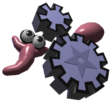Welcome to Framsticks open source software management!
If you are a human who wants to browse Framsticks public repository, you can enter after answering this simple question: What is 1+2 ?
If you are a bot trying to scrap this website, don't.
To download all the sources (the entire repository at once), use the svn client (svn checkout) or the git client (git svn clone) with the URL https://www.framsticks.com/svn/framsticks/ .
